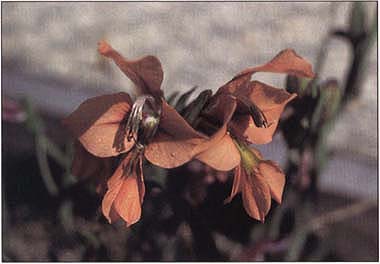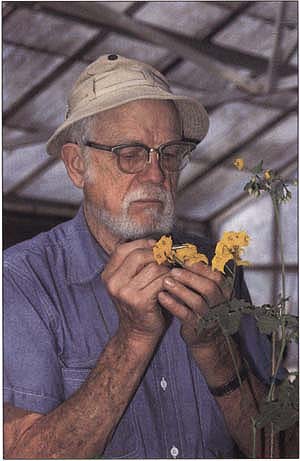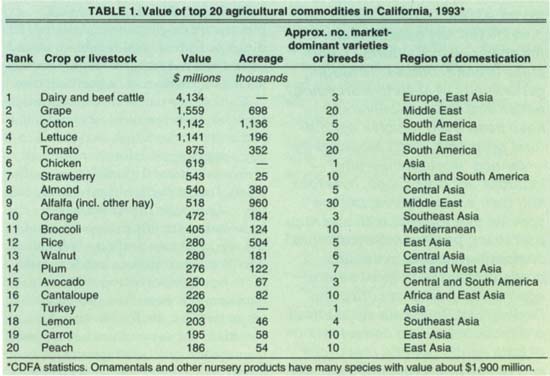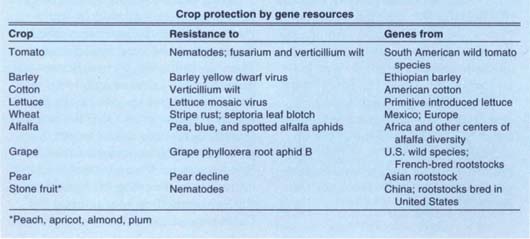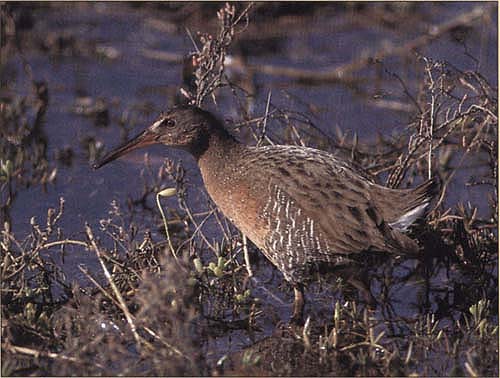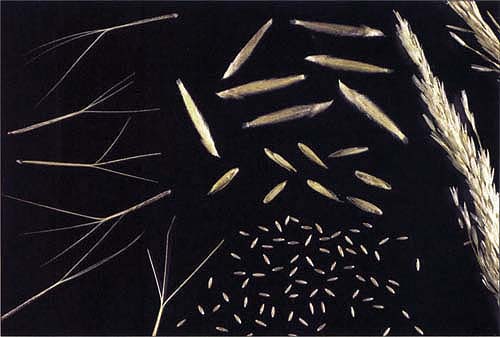All Issues
In California: ‘Agrobiodiversity’ key to agricultural productivity
Publication Information
California Agriculture 49(6):45-49. https://doi.org/10.3733/ca.v049n06p45
Published November 01, 1995
PDF | Citation | Permissions
Abstract
California's rich agricultural productivity is founded on its biological diversity, both native and exotic. Native species contribute genetic resources and play a vital part in preserving land, air and water quality. Exotic species introduced from around the globe provide the raw genetic material for nearly all of California's agricultural commodities. Through generations of selective breeding, native and exotic biodiversity have been used to solve agricultural problems. Such biodiversity — termed “agrobiodiversity” — includes not only crops, livestock and their wild relatives, but the species that interact with and support them: pollinators, symbionts, competitors, pests, parasites, predators and biological control agents. Long-term security and flexibility of California agricultural production requires conservation of both exotic genetic resources and native California habitats.
Full text
Right, Gladiolus alatus is a South African species that is not endangered, but has genetic characteristics that could be used for breeding dwarf characteristics into garden strains of Gladiolus.
Charles M. Rick, founder of the C.M. Rick Tomato Genetics Resource Center, prepares a tomato flower for crossing it to a flower from another plant. Making the cross is the first step in transferring genes from one type of tomato to another.
California has one of the greatest arrays of native biological diversity in the United States, but it is under heavy pressure by people. Direct pressures from human activities take such diverse forms as logging, harvesting mushrooms from the forest floor, collecting medicinal or ornamental plants, farming, fishing and hiking. Indirect pressures on native biodiversity come from reduction or degradation of habitat due to myriad human activities.
California's native human populations for centuries utilized many plant and animal species not recognized today as agricultural, for example, acorns and brine fly larvae (used as food). Today's agricultural commodities in California derive primarily from early agriculturists elsewhere in the world. Domestication of plants into crops and animals into livestock races was a critical component of human survival. Selection, generation after generation, resulted in current commodities. Agriculture has evolved through the genetic adaptation of biodiversity to the special needs for human sustenance. “Agrobiodiversity” refers to all crops and livestock, their wild relatives, and the species that interact with and support these species: pollinators, symbionts, pests, parasites, predators and competitors.
Diversity in agriculture
California agriculture ranks first in the United States in farmgate value and presents one of the greatest displays of biological diversity in the world. This is evident in more than 250 different crops grown, a diverse and large food animal industry, a rapidly evolving aquaculture industry, a vast array of ornamental plants, and numerous industries associated with large and small companion animals. The agricultural industry, one of the largest single segments of the California economy, has developed chiefly from and still depends upon introductions of domesticated plants and animals from other parts of the world. For example, the top 20 commodities in California in 1993 based on monetary value all originated elsewhere in the world (table 1). These crop varieties and livestock breeds are the products of generations of selective breeding, and are fine-tuned to specific agricultural habitats and management regimes.
While the agrobiodiversity in California is extensive, we find large areas where relatively few types of crop plants are grown. These areas of relative uniformity or “monoculture” have developed for a host of reasons. Specific climates and soil types favor relatively uniform production areas. Also economic considerations, including government policy on acreage, production, and price controls for certain commodities generally promote the production of large areas of a few crops. However, diversity in the agricultural system is critical to long-term income stability and natural resource conservation.
Research on agrobiodiversity is a component of the sustainable agriculture movement that strives to maintain farm income with reduced risk of loss due to pests and by reduced use of toxic materials. New and alternative crops and livestock enterprises should be researched for adoption in California agriculture, but research funds are mostly available for existing, highprofile commodities.
Genetic diversity
Because crops and livestock are selected for high productivity and consumers expect uniform quality, there is concern that the resulting uniformity could result in vulnerability to diseases or reduced resilience to extremes in temperature, available water and other factors. Biological diversity within a species or “genetic diversity” is exploited by breeders for selection of types to meet local needs. For example, cotton grown in the San Joaquin Valley must meet very strict standards of fiber quality. This quality was found in a type of cotton known as Acala. For many years, until 1979, the San Joaquin Valley was designated by state law as a “one variety district” where only Acala cotton could be grown. When it was realized that Acala-type fiber quality could be produced by an array of varieties, the legislation was changed to allow production of any variety that maintained the fiber quality attributes of the Acalatype cotton. This spurred industry members to recommend a change in the law. As a result, today 17 varieties are grown, a change which increased genetic diversity and reduced the crop's vulnerability to diseases and environmental extremes.
For most commodities grown in California, relatively few distinct varieties or breeds produce most of the marketed product (table 1). However, there are usually many “minor” varieties of crops grown by farmers that greatly increase the overall agrobiodiversity. For example, plums, which are grown for fresh and dried uses, are represented mainly by seven varieties, which produce 65% of the marketed crop, but more than 150 varieties are grown in California for characteristics such as flavor, early or late ripening time and environmental tolerances. Other similar examples are lettuce, alfalfa and carrot.
Genetic diversity exists as variation among and within crop varieties and livestock breeds. Such genetic diversity provides a buffering effect, stabilizing productivity over time. However, genetic uniformity often results in higher yields and products of very similar properties that are desired by manufacturers and consumers. The example of cotton shows that high productivity, uniform quality, and genetic diversity can be achieved through plant breeding programs.
The level of genetic diversity in livestock breeds varies with respect to the level of control of the production environment and with respect to the level of industrialization of a region's economy. For example, in California, highly industrialized and with highly controlled production environments, more than 90% of dairy cows and nearly all chickens used for commercial egg production are single breeds, Holstein and Leghorn, respectively. In contrast, many African, Asian and Latin American countries retain substantial and diverse populations of native cattle and village chickens, representing a large gene pool for potential adaptation to a wide range of environments, diseases and product types. For California, then, it is necessary to preserve breeds not currently important commercially.
Genetic resources
The California agricultural system, based largely on introduced plants and animals, requires many measures to sustain high productivity. Pest control is essential and can take many forms, including the timing of crop cycles, introduction of genetic resistance or tolerance to the pests, application of natural and synthesized chemicals, and use of living entities that are parasites or predators of the pest organisms. The concern that chemical use may jeopardize applicator or consumer safety has prompted more efforts to introduce genetic resistance or find other biologically based controls. Any organism having characteristics useful in improving or sustaining crop or animal production is a genetic resource because the genes that control the desirable trait can be introduced into the agricultural system. (See “California crops resist pests and diseases” below.)
Living biological control agents, such as wasps that parasitize insect pests, can often be found in the pests' ancestral homes. These organisms can be introduced, multiplied and released to control the targeted pest. This method of biocontrol requires detailed understanding of the life history and biological requirements of the control agent. In addition, scientists must evaluate the pest potential of the agent to avoid introducing an organism that may become a pest itself.
Genetically based host resistance obviates the use of chemicals and is effective against most pests. Genes conveying host resistance are often found in the ancestral home of crops or livestock. Successful employment of this measure first requires gene resources that convey resistance, then the transfer of these genes into the plant or animal. Gene transfer has traditionally been done by hybridization of the organism with the desired gene to the locally adapted crop plant or animal, then selection of progeny having the desired trait. This method of breeding is time-consuming and expensive, partly because the genetic resource must be hybridized through the usual mating system for the species.
Recent discoveries in molecular biology have resulted in new methods to transfer genes from any species to any other species by the process of gene transformation. The desired gene is transferred to a vector, which can be part of a bacterial or virus genome, then the vector is introduced into a plant or animal where it becomes incorporated into DNA, the replicating genetic material. Through molecular biology, the genetic resource base is theoretically unlimited. UC scientists and others are performing intensive research to discover useful genes and methods for their efficient transfer to agricultural species. Products of such research — Asgrow Seed Company's virus-resistant crook-necked squash, Calgene's long shelf-life tomato and herbicide-resistant cotton, Monsanto's insect-resistant potato, and so on — are beginning to be introduced into the marketplace.
Genetic conservation
Ensuring the future of California agriculture requires that genetic resources be accessible for animal and crop improvement and for basic research on agricultural and biological systems. For most crop plants, it is expedient to conserve seeds or plants in seed banks or living collections. This is termed ex situ conservation, that is, collecting genetic materials from throughout the distribution of the crop, especially in its center of origin, and maintaining them in a gene bank. For example, California scientists have collected grape genetic resources from East Asia and tomatoes and wild relatives from South America. These materials are preserved in gene banks at the University of California and elsewhere in the U.S. National Plant Germplasm System.
The primary unit of conservation for livestock is the breed. Genetic stocks are much less common for livestock in contrast to plants and laboratory animals. An exception is poultry, species of which also serve as laboratory animals and medical models. There is only a nascent federal animal conservation program in contrast the National Plant Germplasm System. Major breeds are maintained by producers and many more breeds are preserved by farmers and fanciers. At UC, collections of animal genetic resources are maintained by research programs in the basic biological, medical, and veterinarian sciences and by research programs affiliated with breed improvement.
California crops resist pests and diseases
On numerous occasions outbreaks of pests and pathogens have caused significant losses to California crops. In many cases, control has been achieved with resistant crop varieties introduced from other areas or by introducing pest resistance genes through traditional plant breeding, resulting in many millions of dollars annually in added value or protected crop production.
Currently, the emergence of Type B grape phylloxera has or will severely damage about 70% of California vineyards, based on the susceptible AxR#1 rootstock. Resistant rootstocks provide the only practical and safe means of controlling this pest; fortunately, such stocks are available and are being used to replace existing plants and for establishing new vineyards. Saving the California grape industry is costly, about $15,000 per acre for replanting a vineyard and loss of production for about 3 years. The total statewide cost of transition to resistant rootstock has been estimated at about $1 billion, but this investment is needed to protect the $1.5-billion annual value of this major California industry. Phylloxera resistance is found in American wild grapes and this source was used to save the European grape industry earlier in the 19th century. This resistance is being returned to the California industry in the form of recently bred European rootstocks. Some other examples of crop protection by gene resources are shown below.
Exotic diversity
Some exotic animals introduced as beneficial species have become feral pests. Native ground-nesting birds such as the light-footed clapper rail have been devastated by the red fox, which was introduced for fur farms.
Just as immigrants brought their crops and livestock to California, they brought many undesirable species. These include many weed species that require significant interventions for control in crops (herbicides represent the most commonly used agricultural chemical in field crops). In addition, species originally introduced for agricultural purposes have escaped and become problems in natural and disturbed habitats and cultivated areas. Disease-causing organisms and insect pests were also introduced, resulting in an unwanted enrichment of biodiversity in California. Because introduction of exotic pests is a constant threat, strong regulations about importation and quarantine have been established at federal and state levels. The Mediterranean fruit fly is an example of a potentially damaging pest of the citrus crop, valued at about $1 billion annually. Since 1975 more than $250 million of public funds have been expended in attempts to eradicate this pest in California.
Millions of acres of range and wild-lands become green after the fall rains germinate seeds of annual grasses, such as fescue, brome and wild oats. These plants, introduced from Europe and the Mediterranean region in the last century, replaced the native perennial grasses eliminated in large part by increasing intensities of livestock. While these annual grasses can be managed to provide useful feed for livestock and control of soil erosion, exotic species have contributed to the degradation of native grasslands and other natural habitats.
Some exotic animals introduced as beneficial species during the settlement of California have escaped containment and become feral pests. These include pigs, burros, horses and goats whose effects on vegetation and habitat for native species can be devastating. Another example is the red fox, introduced for fur farms, which competes with native species such as the San Joaquin kit fox and has devastated native ground-nesting birds, such as the light-footed clapper rail and the California least tern.
California has no native genetic resources that have contributed genes to domestic mammals, but bighorn sheep are a potential genetic resource for domestic sheep. Bighorn sheep possess traits, such as predator avoidance and water stress resistance, that would be valuable in domestic sheep. For species managed for aquaculture, the situation is very different. Native genetic diversity contributes greatly to the productivity of California's salmon, trout, abalone and shrimp fisheries, among others.
The state also has genetic resources of wild relatives of several crop plants (sunflower, strawberry, walnut, lupine and others) that occur as native biodiversity. These materials have been collected and included in gene banks, but they should also be preserved in situ in their native habitats. The value of in situ conservation is that it allows for the continued genetic adaptation of the species to its environment, which is especially important as environmental changes occur; however, there is risk if that habitat is threatened. For example, some relatives of strawberry occurring in coastal areas have been destroyed by housing developments. There are some native California species that are used commercially elsewhere, but not in California; these are rare cases. Perhaps the best example is Monterey pine, grown in massive commercial plantations in the southern hemisphere. The few scattered wild populations in California represent almost all of the native genetic diversity for this species.
International exchange of genetic materials will always be essential for California, with both industrialized and developing countries. However, an agreement proposed at a 1992 international meeting may restrict such exchanges. The 1992 international Convention on Biological Diversity acknowledges national ownership of, and responsibility for, biological materials. This Convention allows countries to limit access to genetic resources. At the same time, all countries would be required to acknowledge intellectual property rights of genetic materials they wish to introduce from other countries. These developments may have an important bearing on the access and utilization of genetic resources and international trade of seeds and other materials. This potential restriction means even greater value accrues to existing collections of genetic resources in California. While every country has been invited to sign the agreement, and more than 100 have done so, as yet the United States has not.
Habitat conservation
To the extent possible, biological diversity should be conserved in its natural environment. For agrobiodiversity, this means that crops and livestock would be conserved in situ in their agricultural environments. Since agriculture is dynamic in an industrialized state such as California, it is unlikely that conservation of varieties and breeds on farms can be depended on as a long-term conservation solution. In the short-term, however, voluntary networks of farmers, fanciers, and gardeners in California maintain an extensive diversity of varieties and breeds. Biocontrol species present special conservation problems because of their dependence on potentially scarce food sources and distinct environmental conditions.
Government programs, such as the Conservation Reserve Program, pay landowners for not cropping their land. These areas, if under long-term reserve status, can be significant for conservation of wild crop relatives, insects and animal species. Other lands obtained through private and public cooperation, such as through The Nature Conservancy, have been very successful in developing compatible agricultural and biological conservation goals. Cooperation of local, state, and federal government agencies; UC; landowners; communities; and public conservation groups is emerging as an effective means for meeting mutually acceptable biodiversity conservation goals. Native habitat is steadily being converted to industrial, urban and agricultural uses. Agricultural lands are being transferred to industrial and urban uses at a great rate in California. Efforts to preserve agricultural lands should be encouraged, as for example, through the American Farmland Trust.
Seeds of some California native grasses. Clockwise from left to center, Aristida hamulosa, Nassella pulchra, Muhlenbergia rigens, Agrostis exgrata and Poa securda.
Conservation of natural habitats has immense value for agriculture in the broad sense. The services that natural ecosystems provide to agriculture and other human endeavors are most apparent after they are lost. Examples include loss of wetlands leading to reduced groundwater recharge, large-scale habitat destruction leading to reduced capacity of landscape to store and slow runoff with subsequent flooding and erosion, loss of spawning and nursery grounds for important commercial fisheries leading to reduction in their yield, and the degradation of soil ecosystems leading to crop yield reduction and increased costs of fertilization and pest control.
UC maintains 11 field stations and four experimental areas, designed as sites for agricultural, ecological and biological research. These sites are underutilized for maintaining genetic resources of locally used agricultural species. UC's Natural Reserve System maintains 32 sites for teaching and research purposes, representing many of the natural habitats in California. In addition, UC researchers maintain many ex situ collections of genetic resources relevant to California agriculture. Thus UC plays an important role in maintaining agrobiodiversity for California.



